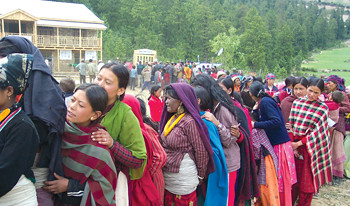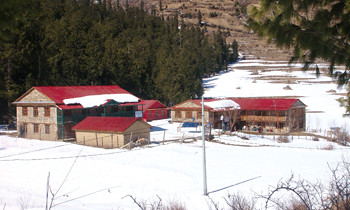One man’s greed has robbed Humla’s people of accessible and quality healthcare in their district
Perched on a hill overlooking the black topped Simikot airport in
Humla, Citta Hospital is an anomaly in one of the remotest regions of the country. The spacious three building complex with clean corridors, well-stocked medicine cabinets, and cosy interiors stands in stark contrast to the reality outside.
Supported by Citta USA Yeshe Lodoe Lama (pic, right), a local from Burause village, established Citta Medical Centre in 2004. Over the years, Lama upgraded the centre which was initially housed in a two storey mud structure into a 15 bed hospital equipped with an operation theatre and special emergency wards. Humlis, who have been neglected for far too long by Kathmandu, were overjoyed to finally have access to world-class health services right at their doorstep and proud of the boy next door. Unfortunately, their euphoria was short-lived as it soon became apparent that the doctor with a golden heart was scamming them all.
Rumours of financial irregularities and mismanagement of funds had been simmering for a long time. To begin with, Lama bought land for the hospital in his father Tsering Lama’s name and appointed his family members and relatives on the board over time. Seventy-year-old Tsering is registered as a caretaker at the hospital and pockets Rs 10,000 every month.
The hospital is even known to sell donated medicines at exorbitant prices. “In the beginning we were so happy to get free medicines and have doctor who would stay in the district for the long-term,” says 50-year-old Jadendra Sunar of Simikot who works as a construction worker nearby, “but now we are made to pay Rs 400 just for vitamins and doctor Lama is here only during health camps.”
Supported by artist Michael Daube, executive director of Citta USA, the hospital had an annual budget of almost $ 90,000 until funding was stopped last year in September after Daube discovered that his doctor friend might not even be a real physician. Volunteers over the years had raised concerns over Lama’s medical qualifications, but the donor naively ignored these early red flags.
The last straw came in the summer of 2012 when a team of Spanish doctors conducting a health camp at Citta tipped off Daube. “If Lama knew anything about general surgery, he would realise that 100 surgeries per day in one surgical room is impossible,” says Marta Faig, a Spanish physician who stayed at the hospital for over a month. It looks like Lama, who claims to be an MBBS graduate from Banaras Hindu University, has not even graduated from high school (see box).
Daube first met Lama in 1997 at a monastery in Sarnath, India where Lama was ‘studying’ medicine and sought of Humla. In a district with health indicators much worse than rest of the country, a skewed doctor to patient ratio (two doctors for every 10,000 population), and decrepit government hospitals that regularly run out of essential medicines, it was all too easy for Lama to convince the well meaning American to invest.
Says Daube: “All these years I thought I was helping a young doctor who sacrificed a lucrative medical career in the city to improve the health of fellow Humlis.”
Now being run as HEED Nepal, the hospital employs 14 people including a nurse, two health assistants, two auxiliary nurse mid-wives, health assitants, and administrative staff, but the doctor is hardly ever in town. Despite being fully equipped, the brand new machines remain wrapped in plastic sheets and only patients with minor cuts, injuries, or respiratory problems are treated. Staff nurse Dikki Sherpa says the number of visitors has sharply declined ever since the controversy.

WANDA VIVEQUIN
LONG WAIT : Patients queue up outside Citta Hospital during a health checkup in 2008. In the absence of a long-term doctor, the hospital’s premise and medical equipment are used only during health camps.
In February, Daube lodged a complaint against Lama at the district administration office in Kathmandu for misappropriating funds. Although Lama submitted audit reports, Daube says they were neither timely nor transparent. Records at the Social Welfare Council also show that the ‘doctor’ never updated information about the organisation after registering it in 2004.
Many former staff have come forward as witnesses and alleged Lama of everything from creating fake audit reports to taking heavy cuts from employees’ salary. Pema Sonam (name changed) a nurse who worked at Citta a few years ago wasn’t too shocked to learn about the scale of corruption. “Most people who work there are Yeshe’s relatives which makes it easier for him to embezzle money,” she admits. “There are two account systems: one to show the donors and the other to track the real amount of medicines that are sold to patients.”
Local authorities too seem to be aware of Lama’s dirty games. “Questions about his credentials have been raised for quite a while, but there wasn’t much we could do,” explains Rabin Khadka, chief district health officer at Simikot. The hospital is notorious for overprescribing and overcharging for antibiotics and vitamins. Many Humlis have ended up overdosing on antibiotics and turn up at the district health office, sometimes close to death says Khadka.
But it’s not just Daube that Lama hood winked. Countless other donors were caught in the elaborate trap says Wanda Vivequin, a freelance writer based in Canada whose work at Citta became the subject of a documentary film bringing in more money to Simikot.
When we caught up with Yeshe Lama in Kathmandu, he casually brushed aside these allegations and said selfish foreigners wanted to take credit for his years of hard work and were trying to tarnish his reputation. “I started the hospital to serve the people of Humla and have been running it with the board’s money for all these years. There has been absolutely no outside support except during health camps,” he claimed. When we asked him why Citta became HEED Nepal, he said the name change was necessary after the initial nine year project ended due to financial problems.
Daube, however, is determined to see Lama punished for the blatant plunder of funds meant for the impoverished people of Humla and says he won’t let Nepal’s bureaucratic red tape deter him. “Yeshe is the perfect example of how one man’s greed can hijack an entire community’s prosperity,” he explains. “What is done cannot be undone, but the man needs to know that he can’t get away so easily.”
Citta hospital in Humla
Video of Yeshe Lodoe Lama talking about how Citta hospital was built with the support of individual donors from abroad
Hotel Humla

MICHAEL DAUBE
With Simikot turning into a base camp for trekkers going up towards Mount Kailash and Mansarovar in Tibet, the Lama family plans to foray into the tourism industry and convert the hospital into a hotel. According to one of the family members, Lama registered the land in his father’s name so that he could diversify his business later on.
“I have overheard board members many times talking about how they will eventually develop the hospital into a high end hotel if funds run out,” reveals a source on the condition of anonymity, “it seems like this was the plan all along, no wonder the infrastructure was built so quickly.”
Playing doctor
When Yeshe Lodoe Lama and Michael Daube were planning on setting up Citta Hospital in Simikot, Lama willingly provided copies of his medical degree from Banaras Hindu University (BHU). Since Lama was registered as a medical doctor at the Nepal Medical Council (licence number 4734), Daube did not feel it was necessary to verify the ‘doctor’s’ credentials. However, as complaints about Lama’s medical incompetence kept getting louder, Daube was compelled to double check. What he uncovered left him astounded.
Officials at BHU confirm that the documents Lama presented were never issued by the university. NMC officials, on the other hand, say they aren’t aware about the forged degree. “It’s not possible for us to check the degree because thousands of students sit for NMC’s exams,” says Anita Lama, administrative officer at NMC.
Good neighbours
While the Citta Hospital in Humla is marred in controversy and has failed to make any real impact on the health of the district, Citta USA’s work in India’s health and education sector have been remarkable. Established in 1996 in Juanga,
Orissa the hospital here serves almost 1,000 patients monthly and even performs surgeries and emergency outreach programs. The organisation also partnered with
Vivekananda Public School in 2001, which is one of the leading public schools in Orissa today. The success rate of students in the recent state exams was so high that students from private schools are showing a keen interest to enrol here.
Run by managing director Govinda Chandra Lenka, the setup of Citta in India is very similar to the one in Nepal. “I am not sure if we lucked out in India, but it’s surprising how two similar projects could end up with such different results,” says Daube. “After my experience in Simikot I know I have to be more careful and do detailed ground work before jumping into another venture.”
Underneath it all
When I first met Yeshe in Humla in May 2007 there was just a kitchen building and simple hospital building. He struck me as a very caring and compassionate person who had the best interests of his people at heart.
In early 2008 I began “Caps for cataracts” program to collect caps for the people in Humla. The idea made it to national radio in Canada and soon I was flooded with10, 000 caps. I was also contacted by a film maker called Toby Molins who decided to make a documentary about this project.
As a result of Toby's visiting Humla his family trust decided to donate about £ 50,000 to help with the construction of a surgical building at the hospital. This had to go through a charity in the UK and it was only then that I became aware of how much role Michael Daube played in the hospital. Yeshe was always very reluctant to talk about other people contribution prefering to keep all of us donors separate.
He never mentioned Michael Daube and how much hard work Michael had done and claimed much of the success and construction to his own sacrifices.
Toby's donation was processed and construction on the surgical building proceeded. Yeshe then reached out to me for funding for the operating theatre equipment.
Around that time I organised a screening of the documentary that Toby had made and in one evening with the help of my friends Joanna Wong and Larry Louie raised nearly $10,000 for an eyecamp to be held at Simikot.
Over the years I introduced many people to the project who have supported me. So when I learnt how deep the corruption runs at the hospital I was in tears. We are all disappointed that the fund we raised for the hospital couldn’t provide the service intended for the people in Humla.
Wanda Vivequin, Canada
Yeshe was a porter on a trek I did in 1995 from Simikot to Mount Kailash. Agreeing to Yeshe's request, my wife and I offered to help pay for his schooling, starting in 1995. We ended up paying for both his secondary and university educations as well as for the purchase of land on which to build a hospital in Simikot. Since 1995 donated more than US$30, 000.
After learning what has been happened to the funds, to say we are disappointed and upset is an understatement.
Leo Murray, Hong Kong